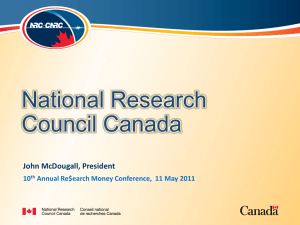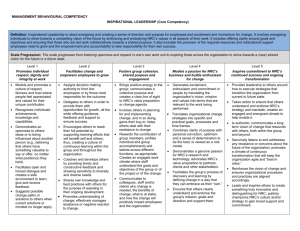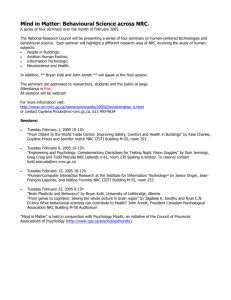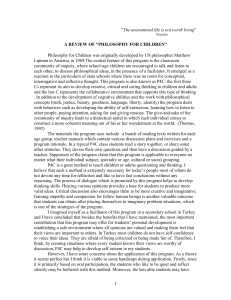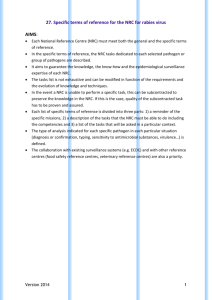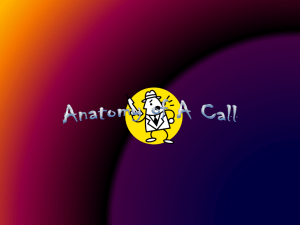Innovation in Canada: Photonics at NRC
advertisement
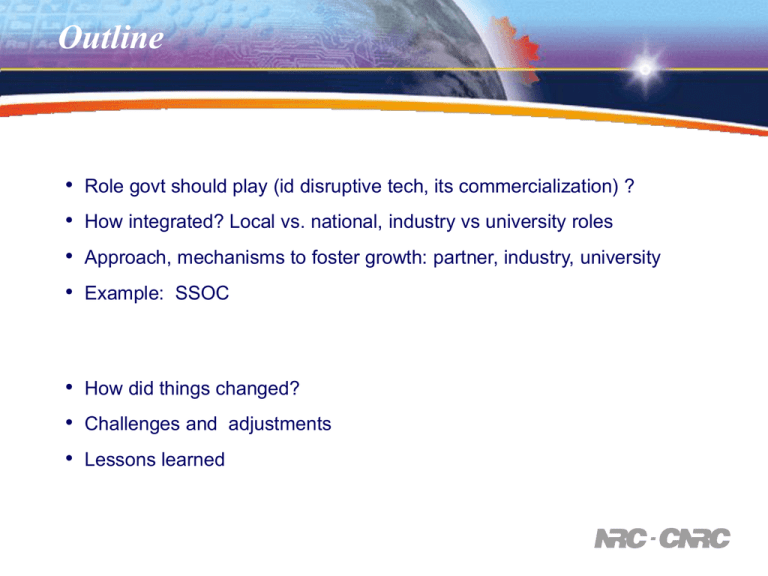
Outline • Role govt should play (id disruptive tech, its commercialization) ? • How integrated? Local vs. national, industry vs university roles • Approach, mechanisms to foster growth: partner, industry, university • Example: SSOC • How did things changed? • Challenges and adjustments • Lessons learned Innovation in Canada •Sustainable Development Technology Fund •Federal Laboratories •Atlantic Regional Innovation Clusters •Biotechnology R&D •Technology Partnerships Canada •Canadian Health Information Highway •Business Development Bank of Canada •Canadian Choices •Canada Foundation for Innovation Knowledge Infrastructure •Networks of Centers of Excellence •PRECARN •Canadian Institutes of Health Research •Canada Research Chairs •Genome Canada •NSERC •Aboriginal Business Services Network •Tax relief - $100 B •Biotechnology Regulation •Canada Business Corporations Act •Privacy / E-Commerce •Competition Act Business Environment Commercialization of Innovation Knowledge Human Resources •Canada Education Savings Grant •Education Tax Credit •Aboriginal Business Canada •SchoolNet / CAP •Millennium Scholarships NRC... • 3,600 full-time employees and 1,200 guest workers in labs and facilities across Canada • Network of technology advisors to support small business • 19 research institutes and 5 innovation and technology centers; focused programs in technology sectors important to Canada’s economy NRC Research Institutes Institute for Aerospace Research Institute for Biological Sciences Institute for Chemical Process and Environmental Technology Institute for Information Technology Institute for Microstructural Sciences Institute for National Measurement Standards Institute for Research in Construction Steacie Institute for Molecular Sciences Canada Institute for Scientific and Technical Information Corporate Branches (ASPM, CS, FB, HRB, IMSB) Innovation Centre – Vancouver Institute for Marine Dynamics St. John’s Institute for Information Technology – Atlantic – Fredericton, Moncton, St. John, Sydney Herzberg Institute of Astrophysics – Victoria, Penticton National Institute for Nanotechnology - Edmonton Institute for Marine Bioscience Halifax Institute for Biodiagnostics – Winnipeg, Calgary, Halifax Plant Biotechnology Institute – Saskatoon Integrated Manufacturing Technologies Institute – London Industrial Materials Institute – Boucherville, Ville Saguenay Biotechnology Research Institute – Montreal Canada’s Innovation Challenges • Find better ways to create knowledge and bring these ideas to market • Find ways to develop, attract and retain the best and the brightest • Support innovation at the local level • Modernize business and regulatory policies Operational • Scope out position and motivation of partners for common interest: get acceptance of all regional partners even if have national mandate • Identify actual need for this • Open communications and sustain to build shared vision • Minimize backroom deals: transparency • Bring integration of process as much as possible • Find workaround govt/institution bureaucratic processes (avoid jail if possible) • Be patient…. • Good science, top quality WDM Transmission System or: What did you drink the night before: disruptive technology Issues at the time: •Govt labs comfortable with long-term horizon projects •Industry found such work of no immediate value •Govt labs interested in advanced components •SMEs looking at niche devices (sensors …) •Universities saw advanced devices as too applied and short-term •No traditions of collaboration between institutions •No common vocabulary •No common working style (Gantt charts, time sheets, stretch goals) SSOC Membership An open consortium of: BNR / NT EG&G MPR Teltech TR Labs ITS Electronics Seastar Optics DND Litton systems Affiliates: CRC NRC (IMS) NOI University Programme: Queen’s Laval Toronto Sherbrooke UBC Imperial Coll. TUNS WORKING TO ACHIEVE OPTOELECTRONIC INTEGRATION Goal • To develop the technology of optoelectronic integration, thus combining the advantages of light and high-speed electronics in a single device. •Facilitate collaboration •Establish competitive capability in Canada •Facilitate training of HQP •Propel optoelectronic integration and WDM (disruptive technologies) •Adapt to members specialised needs Positioning: Organisational Government Labs. and / or Consortia Applications Systems • Leadership in strategic niche market opportunities Base Technology • Creative, provocative ideas • Leadership in selected manufacturable strategic technologies Industry • Market Driven Leadership • Tools • Modelling Modules Devices Universities and C. of Excellence • Strategic • Verification • Competence • Suitably educated graduates • Application Leadership Linkages SHARED PRE-COMPETITIVE RESEARCH Output is People with the Technology that Industry needs Industry MUTUAL ASSISTANCE Governments strategic role of participants availability of resources SSOC Universities Centres of Excellence minimize communication barriers critical mass for impact Organisation Member Programs (Related R&D) SSOC/ Member Program NRC Related Program SSOC/NRC Program • >$40M* pa • >$2M pa • $2M pa • 4M pa • Individual • Contracted to - NRC Universities Members • NRC based • Co-ordinated with SSOC Program Members Internal Programs (related r&d only) Technology transfer achieved through • Guest Workers • Graduate Students • Performed by NRC staff • Planned and managed as a whole • Major Projects / Individual Activities OBJECTIVES * >$150M pa if applications development counted MILESTONES MONTHLY REVIEWS Membership Fees / Rights $K pa Guest Workers Principal 250 3 Non-exclusive. Royalty Free Senior 50 1 Non-exclusive. Royalties payable for commercial exploitation 50/ 250 1/3 Associate 10 -- Research Affiliate Negotiable Type Consortium Non-Members N/A Intellectual Property Rights Guaranteed non-exclusive access at normal market rates Non-exclusive. Royalty-free for internal use. "Have made" rights Negotiable with SSOC SSOC 5-Year Program 1. Establish GaAs Device Capability A Fabrication Space, Eq't Expertise B R&D on Wavelength Selection C 2. Advanced GaAs Devices Wavelength Separation/ Amplification Integratable Detectors 3. Advanced Laser Modulator Separation/ Amplifier Device Integrated Waveguides 4. WDM Demo Chip 5. Multiport Hybrid Optical WDM Commission InP Growth Capability D Simple InP Devices InP Process External Material R&D on Electronics Integrated Demonstrator (Wavelength Dependent Processor) Materials Choices & Integrateable Device Wavelength Separation Demonstration Hybrid Optical Demux S Y S T E M S Integrated Electronics Design A P P L I C A T I O N S Component Choices Demonstrator Choices 90° Waveguide Turning Mirror Core Programme InP facilities and devices Integration issues Bidirectional WDM Rx-Tx InGaAs/GaAs Tx-Rx demonstrator Member’s Programme CRC TRLabs MPR NOI EG&G DND BNR Electronics Tx-Rx LAMDA, M-Z mod systems study modelling soft. dev. InP laser dev. fiber micro. direct DFB lith. Novel Devices University Programme circular grating lasers direct write DFB grating process visible SEHG lasers and NARROW VCSELs OPO at 1.3 and 1.5mm Queen’s Toronto UBC Laval Imperial College Sherbrooke CITR BPM thermal model InP HBT OEIC nl wavelength cntl patterned growth InP PL VCSELs Lasting benefits for Canada •Took nearly two years of talking and exploring (created Aug.1988, sunset Aug. 1995) •Over 60 HPQ found jobs over that 7 years •Several world technology “first” or “records” •Publications, IP, reports and process development •Opto group at IMS grew to 31 •Lasting impact on industry, university and NRC •R&D positions in university, industry •Mixed matrix approach to resources •Closer interdependencies •Value for Canada well documented Summary •typically take more than four years to return any benefits •Research focus was maintained with Core Programme Tx-Rx WDM •to build infrastructure, while being responsive to individual requests. •World record performance for WDM devices and several •Novel Devices patents. •New manufacturing processes successfully transferred, •now part of products as result of effective technology transfers via •guest workers. •Future components for Canada’s “electronic highway” •(CANARIE and OCRI-Net), in addition to members’ systems. Post SSOC, IMS impact • Very high level of R&D partnership (individual firms commercialising results) • • • • • Efficient internal organisation and culture Lasting relationships and clients High quality people, R&D and equipment base Tightly integrated full micro-fabrication capability Spin-offs – – – – – – CrossLight software SiGe Semiconductors Iridian Spectral Technologies MetroPhotonics LNL Optenia Trilium Photonics • Other consortia such as OpCom, Athena, CARC, FIB-OCRI… Emergence in 1990s, post SSOC • SSOC paved the way and shaped culture in combination with OCRI in Ottawa region (Potworowski study, May 2002) • BNR/Nortel: gorilla, Industry NRC: vision, R&D SSOC: applications, technical networking OCRI: facilitator, networking, regional voice • Local universities not active in photonics at the time • Now have Ontario and municipal Govt, U of O, Carleton, Algonquin, OPC, CPC, PRO, IRAP, OCRI, NCIT, OPRA, CPFC, SMC, NRC, Regional Innovation center, Vitesse, IPF, etc….. All helping in unison Industry Partnership Facility (IPF) Industry Partnership Facility • Assist SMEs in ICT sector to exploit emerging technologies • Co-located to NRC staff doing R&D in software and hardware components • • • • Co-located with IRAP Access to CISTI and NRC linkages to expert advice Reduce risk during the critical start-up years 2500 sq.m. of usable space, 15 companies • All new NRC facilities will have one now! The Incubation Process Access to R&D Networks R&D Feedback Specialized Facilities Access to Skilled People Access to Capital Capitalization Networks and Alliances Champions Company Business Development Exchange of Ideas Business Planning Access to Services Coaching and Mentoring Canadian Photonics Fabrication Centre (CPFC) - Ottawa • Unique facility in Canada for industry and universities • Component and device fabrication • Linking photonics clusters to NRC's national facilities, networks, competencies and incubation services • Training of highly qualified personnel The CPFC: Working in Partnership • • • • • • • • • • Algonquin College CIPI COPAC CMC (MOU signed in January 2003) CRC Ontario Photonics Consortium PRO (MOU signed in May 2001) TR Labs (MOU signed in October 2002) University of Ottawa Vitesse (MOU in progress) National R&D Infrastructure Prototyping services for industry – Small firms: Low-volume production; Proof of concept; Design assistance – Medium firms: Low-volume production runs to test manufacturability & designs – Large firms: Fast turnaround, novel runs to test proof of concept Training highly qualified personnel – R&D fabrication facilities for universities, Centres of Excellence, and other research organizations Technology Clusters – NRC’s Approach The Players • • • • • • • R&D institutions (private, university, government) technology intensive firms with global reach entrepreneurs - local champions with vision network catalysts - public and private sector involved/knowledgeable local sources of financing technology brokers & tech transfer centres provincial and municipal governments, local authorities Source: Andy Woodsworth Role: development • • • • • • • • Must not be top down or policy driven Industry driven and industry champion Offer real value, visibility, networking, not just endless meetings Involve the right members not the usual “leaches” Recognize when to manage the cluster Limit bureaucratic overhead (difficult in govt context) Identify real problems not political reasons Create interdependencies Effective “disruptive tech” interactions: - establish strong member commitment. - streamlined decision control. - well defined and focussed Core Programme, in a central location. - maintain one-on-one member research flexibility. - effective technology transfer by on-site workers. - uniform technology base for Core Programme. - select members for complementary values and compatible goals. - work out issues with individual members. - use technical meetings as information transfer and input. Ottawa Photonics Valley Solid State Optoelectronics Consortium (SSOC) - created in 1989 with participation of BNR & SMEs SSOC developed integrated photonic devices for wavelength division multiplexing (WDM) on a single chip. O-Vitesse (Vitesse Re-skilling) to address shortage of software engineers Immigration rule changes for IT workers Incubation - NRC’s IPF 70 NRC spin-offs in Ottawa alone, creating 7000 high tech jobs, with over $1 B sales NRC Technology Cluster Initiatives Aluminium (Ville Saguenay) Ocean Engineering (Newfoundland) Nanotechnology (Edmonton) Fuel Cells (Vancouver)) Astronomy (Victoria, Penticton) Ag-Biotech (Saskatoon) Medical Technologies (Winnipeg) Sustainable Urban IT / Life Sciences Infrastructure (Ottawa) (Regina) Bioactives (PEI) E-Business (New Brunswick, Sydney) Life Sciences (Nova Scotia) Biopharmaceuticals, Industrial Materials (Montreal) Aerospace (Ottawa, Montreal)

